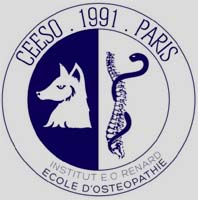Effet de la manipulation HVT C7/D1 sur la rotation externe de l’articulation gléno-humérale
Étude expérimentale
Olivier Vromman

Mémoire en vue de l’obtention d’un diplôme d’ostéopathe - Centre Européen d’Enseignement Supérieur en Ostéopathie — CEESO 2015 - Tuteur de mémoire : Sylvain PIETKA DO - Février 2015
Le Site de l’Ostéopathie remercie le Directeur du CEESO Paris de l’avoir autorisé à présenter ce mémoire
Résumé
Titre : Effet de la manipulation Haute Vélocité Basse Amplitude (HVBA) C7/D1 sur la rotation externe de l’articulation gléno-humérale : étude expérimentale.
Introduction : La scapulalgie correspond au troisième motif de consultation musculosquelettique en ostéopathie. La manipulation des cervicales et des thoraciques est justifiée pour répondre au motif de scapulalgie.
Objectif : Cette étude avait pour but d’observer les effets d’un thrust C7/T1 sur la rotation externe de gléno-humérale pour savoir s’il pouvait y avoir un lien biomécanique étroit entre la charnière cervico-thoracique et l’épaule et ainsi, en justifier son utilisation lors des motifs de scapulalgies.
Méthodes : 43 patients dispersés au hasard dans 3 groupes comparés : un témoin, un light touch et un traitement. La rotation externe de l’articulation gléno-humérale droite a été mesurée chez chacun d’entre-eux avant et après le test. Les résultats des amplitudes observées ont été comparés par analyse statistique.
Résultats : Le HVT C7/T1 diminue la rotation externe de l’articulation gléno-humérale droite de 7,72% dans le témoin, de 1,70% dans le light touch, et de 0,66% dans le traitement.
Discussion : Une diminution de l’amplitude a été observée pour chaque groupe mais il semblerait que le traitement ait un effet protecteur à la fatigabilité des muscles du complexe thoraco-scapulo-brachial.
Conclusion : Il y aurait un lien entre la charnière cervico-dorsale et l’articulation gléno-humérale. L’utilisation du thrust sur la charnière cervico-dorsale serait donc justifié. Cependant, il est difficile de connaître les mécanismes d’action. Il faudrait réaliser davantage d’études à ce sujet afin d’appuyer nos hypothèses.
Mots clefs : épaule, ostéopathie, HVBA, fascia, système nerveux autonome.
Abstract
Title : Effect of C7 / T1 High Velocity Thrust (HVT) on the external rotation of Glenohumeral (GH) joint : an experimental study.
Introduction : Shoulder pain is the third reason for musculoskeletal consultation in osteopathy. Cervical and thoracic’s manipulation are justified in patients presenting with shoulder pain.
Objective : This study aimed to investigate the effects of a C7 / Ti HVT on the glenohumeral joint external rotation in order to see whether a close biomechanical relationship between the GH and the cervicothoracic (CT) joint was observed, hence justifying its indication in shoulder pain.
Méthods : 43 patients were randomly attributed to three groups defined as following : Control group, Light touch group and Treatment group. All groups were compared after results collection. The right GH joint external rotation was measured in each patients before and after intervention. The results obtained from GH joint Range Of Movement (ROM) were compared by statistical analysis.
Résults : CT joint HVT decreased right GH joint external rotation of 7,72% in the Control group, 1.70 for the light touch group, and 0.66% in treatment the group.
Discussion : A decrease in amplitude was observed for each group, however the treatment could apparently have a protective effect on the fatigability of the muscles from the scapular-thoracic-brachial complex.
Conclusion : A link between CT junction and the GH joint might exist. Therefore the use of HVT on the CT junction could be justified. However it is difficult to understand the mechanisms behind it. More research on this domain would need to be done in order to support our hypotheses.
Mesh Terms : shoulder, osteopathy, HVLA, fascia, autonomic nervous system.



